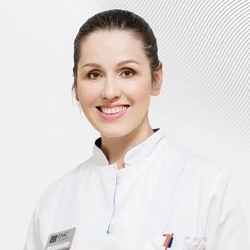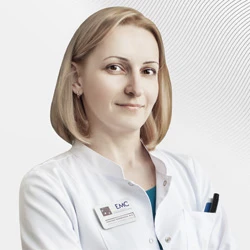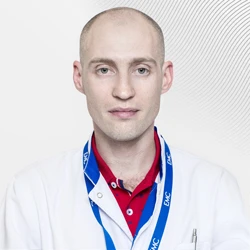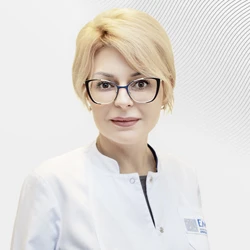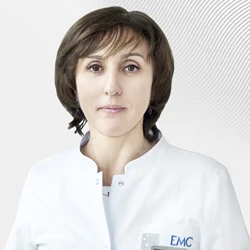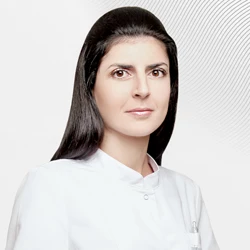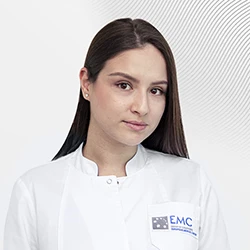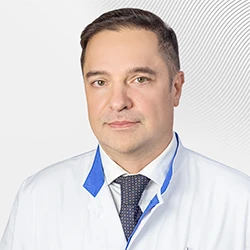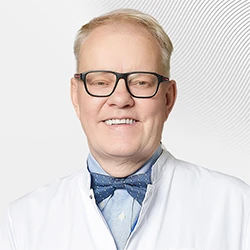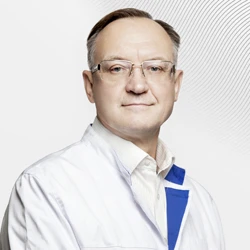Cervical cancer
Narrated by Jean-Rene Millier,
otorhinolaryngologist-surgeon, oncosurgeon
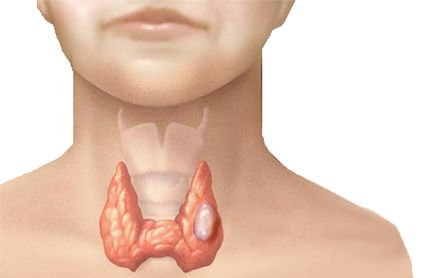 The thyroid gland is an organ of the endocrine system located in on the front of the neck. The thyroid gland produces the hormones thyroxine (tetraiodothyronine, T4) and triiodothyronine (T3), which are involved in regulating metabolism.
The thyroid gland is an organ of the endocrine system located in on the front of the neck. The thyroid gland produces the hormones thyroxine (tetraiodothyronine, T4) and triiodothyronine (T3), which are involved in regulating metabolism.
Risk factors
The causes of thyroid cancer have not been established to date, but research has identified certain risk factors, including:
-
Some benign thyroid diseases (enlargement of the thyroid gland (goiter); thyroid nodules (adenomas); inflammatory diseases thyroid gland (thyroiditis). Hypothyroidism and hyperthyriosis are not risk factors.
-
Exposure to radiation. Patients who have undergone radiation therapy of organs in the neck area are at risk for several years after treatment. Exposure to high doses of radiation as a result of man-made disasters, such as during the Chernobyl nuclear power plant accident, can also cause the development of thyroid cancer.
-
Hereditary gene anomaly. A low risk of developing thyroid is associated with the inheritance of a gene that causes familial adenomatous colon polyposis.
Gender also matters: thyroid cancer is more common in women.
Types of thyroid cancer
-
Papillary (the most common type of thyroid cancer, which is characterized by slow growth, is more common in young people, mainly in women).
-
Follicular (a less common type of thyroid cancer, more common in young and middle-aged people).
-
Papillary and follicular cancers are classified as differentiated thyroid cancers. The treatment tactics are similar. The prognosis is favorable in most cases.
-
Medullary (a rare type of malignant thyroid tumors, in most cases genetically determined).
-
Anaplastic (rare and most aggressive type of thyroid cancer. It usually develops after the age of 60).
-
Thyroid lymphoma (this type of cancer develops from the lymphatic tissue of the thyroid gland, most types of thyroid lymphoma belong to non-Hodgkin's lymphomas).
Symptoms
In most patients, thyroid cancer progresses very slowly. The most common symptom is a painless knot in the neck, which gradually increases in size.
Other possible symptoms include:
-
Hoarseness of voice that occurs for no apparent reason and does not go away for several weeks
-
Swallowing disorders – in case of compression by a tumor of the esophagus
-
Respiratory disorders – when the trachea is compressed by a tumor
If a tumor is found in the thyroid gland, it is necessary to consult a doctor as soon as possible. In most cases, the tumor is not caused by cancer.
Diagnosis and treatment
In our clinic, thyroid cancer is diagnosed and treated by a team of specialists with extensive experience in this field. It includes: endocrinologists, oncologists, surgeons specializing in the treatment of head and neck tumors, radiologists and, if necessary, other specialists.
Thyroid cancer diagnosis begins with a doctor's examination, which evaluates changes in the thyroid gland and the presence of risk factors.
The doctor may prescribe such studies as:
- Blood tests to assess thyroid function
- Ultrasound examination. There are no specific signs that make it possible to diagnose thyroid cancer by ultrasound, but some signs suggest malignancy.
- Fine needle biopsy
- Core biopsy
If thyroid cancer is diagnosed, further studies are performed (MRI, CT, PET/CT, checking the condition of the vocal cords) to determine the size and location of the tumor and its spread in the body.
Unfortunately, no study can confirm with complete certainty the cancerous nature except for histopathological analysis of the node. To do this, a fine needle biopsy is performed before the operation. When cancer cells are found in a biopsy, a decision is made to completely remove the thyroid gland. If the histologists did not find cancer in the examined material, and the node is the only one, then a decision is made on hemithyroidectomy (removal of the corresponding lobe of the thyroid gland). During the operation, an urgent histological examination is performed – an express biopsy. If tumor cells are detected, the thyroid gland is completely removed. In their absence, the scope of intervention is limited by hemithyroidectomy (removal of the lobe).
Removal of cervical lymph nodes is performed only if a malignant neoplasm was diagnosed before the operation.
At the European Medical Center, operations are performed by specialized oncosurgeons who know the full range of thyroid surgeries using the most modern minimally invasive treatment technologies, including endoscopic and robotic thyroidectomy.
Endoscopic thyroidectomy
Surgical procedures are performed through a 2-3 cm wide incision in the neck using microinvasive instruments under the control of an endoscope. Visual control of the procedure is provided by a mini video camera, which is located at the end of the endoscopic instrument.
Robotic thyroidectomy
A completely new technology for performing endoscopic surgery using the Da Vinci surgical robot. Three-dimensional visualization and multiple magnification of the surgical field allow surgeons to perform manipulations with the highest precision. In this case, incisions are made in the armpit or behind the ear, which avoids postoperative scars on visible areas of the neck and face.
After thyroidectomy, patients always need replacement treatment. The patient is prescribed a drug with thyroid hormones identical to his own hormones. This treatment does not lead to weight gain, changes in appearance and figure, does not affect mental and physical abilities, as well as the ability to have children.
Author: Jean-Rene Millier, otorhinolaryngological surgeon, oncosurgeon
Why the EMC
The first and only clinic in Russia, created in the image of the world's leading clinics
EMC is a multidisciplinary center offering patients a high level of medical services and a personalized approach
Worldwide recognition and awards
 Learn more
Learn more
Worldwide recognition and awards
 Certificates and licenses
Certificates and licenses
Make an appointment for a consultation
Specify your contacts and we will contact you to clarify the details
Reviews
and new products of the EMC



.webp)



